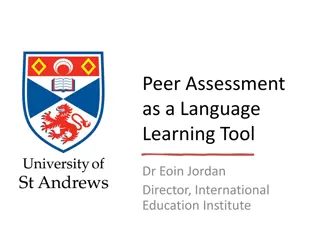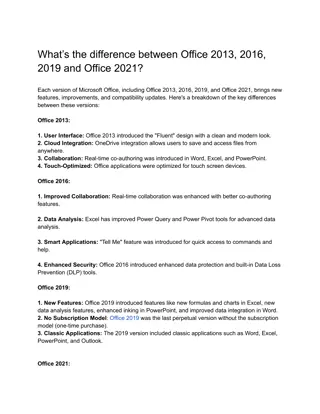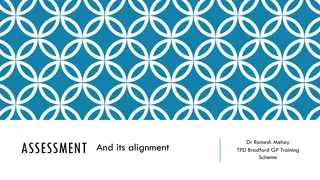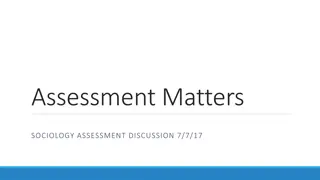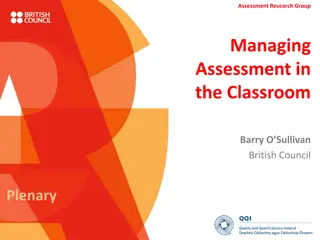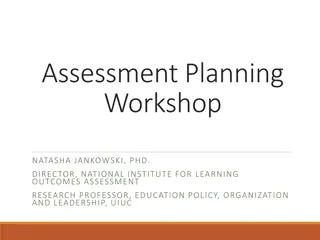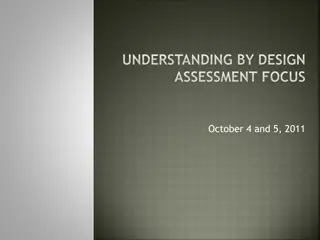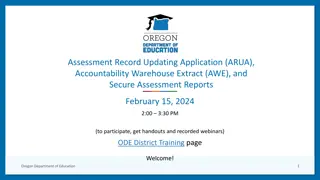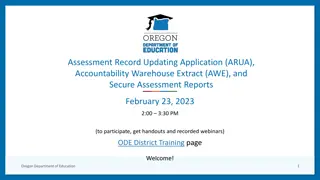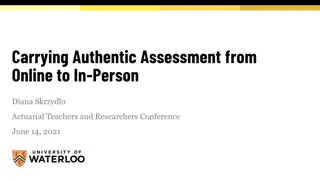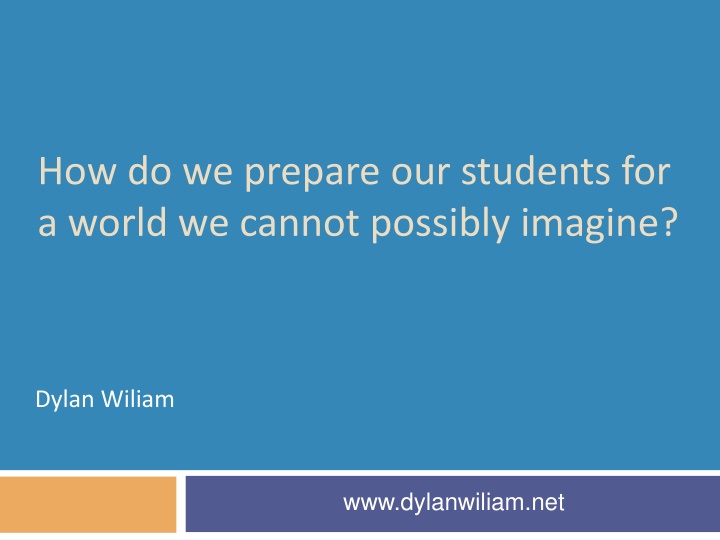
Preparing Students for an Unimaginable Future with Dylan Wiliam's Insights
Explore how education plays a vital role in preparing students for an ever-evolving world, as discussed by Dylan Wiliam. Discover the importance of teacher quality, the dynamic landscape of work, and the evolving philosophies of education to equip students for success in an unpredictable future.
Download Presentation

Please find below an Image/Link to download the presentation.
The content on the website is provided AS IS for your information and personal use only. It may not be sold, licensed, or shared on other websites without obtaining consent from the author. If you encounter any issues during the download, it is possible that the publisher has removed the file from their server.
You are allowed to download the files provided on this website for personal or commercial use, subject to the condition that they are used lawfully. All files are the property of their respective owners.
The content on the website is provided AS IS for your information and personal use only. It may not be sold, licensed, or shared on other websites without obtaining consent from the author.
E N D
Presentation Transcript
How do we prepare our students for a world we cannot possibly imagine? Dylan Wiliam www.dylanwiliam.net
Overview 2 Why education matters The changing world of work The role of teacher quality in improving education Why most of the strategies being pursued in the U.S. won t work What we should be doing ?
What is the purpose of education? 3 Four main philosophies of education Personal empowerment Preparation for citizenship Cultural transmission Preparation for work All are important Any education system is a (sometimes uneasy) compromise between these four forces ?
Recession (2008-2010) and recovery (2010-2012) 4 Those with a high school diploma or less lost 5.6 million jobs in the recession, and lost a further 230,000 jobs in the recovery Those with an Associate s degree lost 1.75 million jobs in the recession, but gained 1.6 million jobs in the recovery Those with at least a Bachelor s degree gained 187,000 jobs in the recession, and gained a further 2 million jobs in the recovery Carnevale, Jayasundera, and Cheah (2012) ?
The world of work is changing Education level Change in salary 1978 to 2005 Postgraduate qualification +28% BA/BSc Some college +19% 0% High school diploma 0% High school dropout -16% Economic Policy Institute (2010) ?
in ways that are hard to predict Skill category Percentage change 1969- 1999 +14% Complex communication Expert thinking/problem solving +8% Routine manual Non-routine manual 3% 5% Routine cognitive 8% Autor, Levy & Murnane (2003) ?
Computers in medical diagnosis 7 Pilot study of the use of neural nets to predict biopsy results Sample: 1,787 men with a serum prostate-specific antigen (PSA) concentration > 4.0 ng/ml Data: Age Maximum PSA concentration over all visits Average PSA concentration over all visits Maximum digital rectal examination over all visits Maximum transrectal ultrasonography results over all visits Change of PSA value between visits Positive predictive value (% of those predicted with positive biopsies) Specialist urologists: 34% Artificial neural nets: 77% Snow, Smith and Catalona (1994) ?
Off-shoring and automation Off-shoreable Not off-shoreable Radiographer Security analyst Tax accountant Surgeon (?) Bricklayer Hairdresser Skilled Food packager Data entry clerk Call centre operator Grocery store clerk Receptionist Retail salesperson Unskilled ?
The coming war for jobs (Clifton, 2011) Right now 7 billion people on earth 5 billion adults 3 billion people who want to work 90% of these want to work full time As a consequence 2.7 billion full-time formal jobs are wanted with only 1.2 billion full-time formal jobs available A shortfall of 1.5 billion jobs So, for every US worker, there are 10 people who would like their job ?
Meet Maddie Parlier Davidson (2012) ?
There is only one 21st century skill 12 So the model that says learn while you re at school, while you re young, the skills that you will apply during your lifetime is no longer tenable. The skills that you can learn when you re at school will not be applicable. They will be obsolete by the time you get into the workplace and need them, except for one skill. The one really competitive skill is the skill of being able to learn. It is the skill of being able not to give the right answer to questions about what you were taught in school, but to make the right response to situations that are outside the scope of what you were taught in school. We need to produce people who know how to act when they re faced with situations for which they were not specifically prepared. (Papert, 1998) ?
Successful education? 13 The test of successful education is not the amount of knowledge that a pupil takes away from school, but his appetite to know and his capacity to learn. If the school sends out children with the desire for knowledge and some idea how to acquire it, it will have done its work. Too many leave school with the appetite killed and the mind loaded with undigested lumps of information. The good schoolmaster is known by the number of valuable subjects which he declines to teach. The Future of Education (Livingstone, 1941 p. 28) ?
Wheres the solution? Structure: Smaller/larger high schools K 8 schools/ All-through schools Alignment: Curriculum reform Textbook replacement Governance: Charter schools Vouchers Technology: Computers Interactive whiteboards Workforce reforms ?
Pause for reflection What s the most interesting, surprising, or challenging thing you have heard so far? See if you can get consensus with your neighbors ?
School effectiveness 16 Three generations of school effectiveness research: Raw results approaches: Different schools get different results. Conclusion: Schools make a difference. Demographic-based approaches: Demographic factors account for most of the variation. Conclusion: Schools don t make a difference. Value-added approaches: School-level differences in value-added are relatively small. Classroom-level differences in value-added are large. Conclusion: An effective school is a school full of effective classrooms. ?
We need to focus on classrooms, not schools In the USA, variability at the classroom level is at least four times that at school level. As long as you go to school, it doesn t matter very much which school you go to. But it matters very much which classrooms you are in. It s not class size. It s not the between-class grouping strategy. It s not the within-class grouping strategy. ?
And most of all, on teachers 18 Take a group of 50 teachers: Students taught by the most effective teacher in that group of 50 teachers learn in six months what those taught by the average teacher learn in a year. Students taught by the least effective teacher in that group of 50 teachers will take two years to achieve the same learning (Hanushek & Rivkin, 2006) And furthermore: In the classrooms of the most effective teachers, students from disadvantaged backgrounds learn at the same rate as those from advantaged backgrounds (Hamre & Pianta, 2005).
How do we improve teacher quality? A classic labor force issue with two (non-exclusive) solutions: Replace existing teachers with better ones. Help existing teachers become even more effective. ?
Heres what we know about teaching 20 We don t know who will be good teachers We can t always guarantee good teaching: from teachers qualifications by classroom observation by looking at value-added test scores ?
Teacher qualifications and student progress 22 Mathematics Mathematics Reading Reading Primary Primary Middle Middle High High Primary Primary Middle Middle + High High General theory of education courses education courses General theory of Teaching practice Teaching practice courses courses Pedagogical Pedagogical content courses content courses + + Advanced university courses university courses Advanced + Aptitude test Aptitude test scores scores Harris and Sass (2007) ?
Framework for teaching (Danielson 1996) 24 Four domains of professional practice 1. Planning and preparation 2. Classroom environment 3. Instruction 4. Professional responsibilities Links with student achievement (Sartain, et al. 2011) Domains 1 and 4: no impact on student achievement Domains 2 and 3: some impact on student achievement ?
A framework for teaching (Danielson, 1996) Domain 2: The classroom environment 2a: Creating an environment of respect and rapport 2b: Establishing a culture for learning 2c: Managing classroom procedures 2d: Managing student behavior 2e: Organizing physical space Domain 3: Instruction 3a: Communicating with students 3b: Using questioning and discussion techniques 3c: Engaging students in learning 3d: Using assessment in instruction 3e: Demonstrating flexibility and responsiveness ?
Reading 0.5 0.4 2a 0.3 2b 0.2 2c Teacher value-added 0.1 2d 0 2e 3a -0.1 3b -0.2 3c -0.3 3d -0.4 3e -0.5 Unsatisfactory Basic Proficient Distinguished -0.6 ?
Mathematics 0.6 2a 0.4 2b 0.2 2c Teacher value-added 2d 0 2e 3a -0.2 3b 3c -0.4 3d -0.6 3e Unsatisfactory Basic Proficient Distinguished -0.8 ?
Observations and teacher quality 28 Reading Mathematics 20 So, the highest rated teachers are 30% more productive than the lowest rated Percentage change in rate of learning 15 10 5 0 -5 But the best teachers are 400% more productive than the least effective -10 -15 Unsatisfactory Basic Proficient Distinguished Sartain, Stoelinga, Brown, Luppescu, Matsko, Miller, Durwood, Jiang, and Glazer (2011) ?
Imprecision of lesson observations 29 Achieving a reliability of 0.9 in judging teacher quality through lesson observation is likely to require observing a teacher teaching 6 different classes, and for each lesson to be judged by 5 independent observers. Hill, Charalambous and Kraft (2012) ?
Teacher value-added Value-added quintile: Student fixed-effects model 1 2 3 4 5 Value-added quintile: 1 38 22 24 16 0 Traditional model 2 26 28 15 20 11 3 20 20 20 24 16 4 13 24 26 13 24 5 9 5 12 28 47 Goldhaber, Goldschmidt, and Tseng (2013) ?
Change in mathematics teacher over time Quintile of teacher value-added 5th 4th 3rd 2nd 1st 0.5 0.4 Value-added (student SDs) 0.3 0.2 0.1 0 -0.1 -0.2 0 1 2 3 4 -0.3 Years of teaching experience Atteberry, Loeb and Wyckoff (2013) ?
Correlation of initial and later performance 33 All teachers New teachers 0.5 Correlation of value-added with base year Mathematics 0.4 0.3 0.2 0.1 0 Base+1 Base+2 Base+3 Base+4 Base+5 Year of prediction ?
Correlation of initial and later performance 34 All teachers New teachers 0.5 Correlation of value-added with base year Reading 0.4 0.3 0.2 0.1 0 Base+1 Base+2 Base+3 Base+4 Base+5 Year of prediction ?
Issues with value-added models for teachers 35 Different (reasonable) models of value-added give very different estimates of teacher quality (Goldhaber, Goldschmidt and Tseng, 2013) Teacher value-added in their first year accounts for less than 5% of the variation in teacher quality in their fifth year of teaching (Atteberry, Loeb and Wyckoff, 2013) Teachers benefit students for at least three years after they stop teaching them (Rothstein, 2010) ?
36 To recap The highest rated teachers generate learning 30% faster than the lowest rated teachers But the most effective teachers generate learning 400% faster than the least effective teachers So the best observation systems we have capture less than 10% of teacher quality (in reality, less than this because most teachers are in the middle two categories) There is therefore a real danger that teachers will game the system by aping features of observation protocols while becoming less effective. ?
Expertise 38 Grandmaster chess players don t have higher IQs than average chess players Top surgeons don t have higher IQs, medical school grades, or higher manual dexterity than average surgeons In general, measures of general ability account for 4% of the variability in performance ?
The role of deliberate practice 39 Music professors at the Hochschule der Kuenst (Academy of Music) Berlin identified 10 violin students who had the potential for careers as international soloists ( best students) The professors also identified a sample of 10 good, but not outstanding students ( good students) Researchers recruited another 10 students training to be music teachers who specialised in the violin ( Music Ed students) An additional 10 middle-aged professional violinists from two local orchestras were recruited to the study Groups were matched in sex (7f, 3m) and for the first three groups, age ?
How much do violinists practice? Music Ed Good Best Professionals 35 Hours of practie per week 30 25 20 15 10 5 0 4 9 14 19 Age Ericsson, Krampe, and Tesch-R mer (1993) ?
Violinists hours of practice (cumulative) 41 Music Ed Good Best Professionals Cumulative hours of practice 10000 8000 6000 4000 2000 0 4 6 8 10 12 Age 14 16 18 20 ?
These differences are substantial 42 Hours of practice by age 18 Music Education students 3420 Good violin students Best violin students 5301 7410 Professional musicians 7336 By the age of 18, the best violinists have accumulated 40% more practice than good violinists Since the amount of deliberate practice being undertaken by the best students once they are adults is close to the maximum possible, it is, essentially, impossible for the good students to catch up to the best. ?
Talent is over-rated 43 ?
General conclusions about expertise 44 Elite performance is the result of at least a decade of maximal efforts to improve performance through an optimal distribution of deliberate practice What distinguishes experts from others is the commitment to deliberate practice Deliberate practice is an effortful activity that can be sustained only for a limited time each day neither motivating nor enjoyable it is instrumental in achieving further improvement in performance ?
Expertise 45 According to Berliner (1994), experts: Excel mainly in their own domain Often develop automaticity for the repetitive operations that are needed to accomplish their goals Are more sensitive to the task demands and social situation when solving problems Are more opportunistic and flexible in their teaching than novices Represent problems in qualitatively different ways than novices Have faster and more accurate pattern recognition capabilities Perceive meaningful patterns in the domain in which they are experienced Begin to solve problems slower but bring richer and more personal sources of information to bear ?
Effects of experience in teaching 46 1 1 Mathematics Reading Extra months per year o f learning 0 0 -1 -1 -2 -2 -3 -3 -4 -4 -5 -5 Years of teaching experience Years of teaching experience 0 1 2 3 to 5 0 1 2 3 to 5 Rivkin, Hanushek and Kain (2005) ?
Implications for education systems Pursuing a strategy of getting the best and brightest into teaching is unlikely to succeed Currently all teachers slow, and most actually stop, improving after two or three years in the classroom Expertise research therefore suggests that they are only beginning to scratch the surface of what they are capable of What we need is to persuade those with a real passion for working with young people to become teachers, and to continue to improve as long as they stay in the job. ?
Two key levers for system improvement 49 A broad and balanced curriculum Effective learning environments
21st Century skills? Cognitive competencies Cognitive processes and strategies Knowledge Creativity Intra-personal competencies Intellectual openness Work ethic/conscientiousness Positive core self-evaluation Inter-personal competencies Team-work Leadership Pellegrino and Hilton (2012) ?



